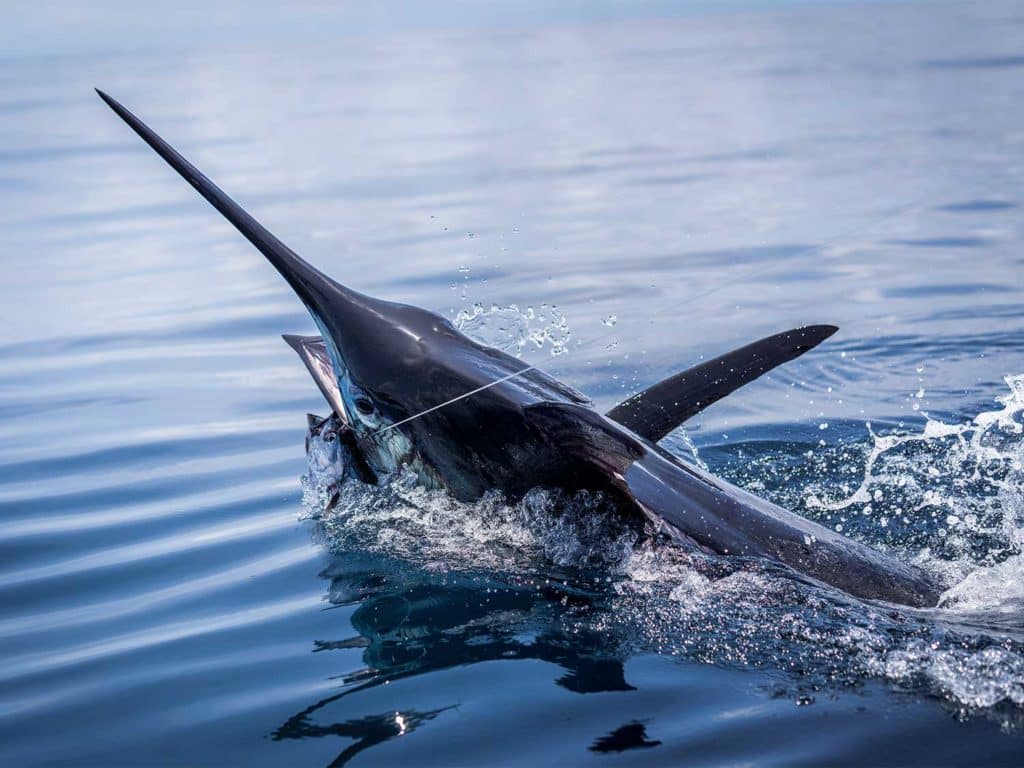
Whenever we discuss IGFA world-record billfish, thoughts of exotic locations and remote destinations usually come to mind: the huge black marlin fishery that exists off Cairns, Australia, and the large blues that prowl the waters of the Azores and Canary Islands. However, it might come as a surprise to some that the opportunity to land a world-record billfish exists much closer to home. The International Game Fish Association currently holds more than 20 billfish world records in the United States, including the fabulous Florida Keys and the cobalt-blue waters of the Hawaiian Islands. Even the Northeast canyons have produced some amazing catches by some talented anglers. So, whether you’re a committed record chaser or casual angler, the opportunity to land a record fish can be found right here in the US.
Nineteen of the 22 line-class records the IGFA holds for Atlantic blue marlin are from the eastern side of the Atlantic Ocean, but in recent years, several grander blues have been landed along the Eastern Seaboard of the US. With major tournaments such as the Big Rock, the Mid-Atlantic and the White Marlin Open, it’s only a matter of time before an angler finds himself hooked into a potential world-record fish. With the turbulent nature of international travel and the uncertainty of what the future holds, there’s no time like the present to explore the fisheries within our own borders.
Watch: We show you how to rig one of the best baits for blue marlin: the swimming mackerel.
Historically, some of the most noteworthy line-class records that the IGFA has approved have been billfish. The concept of landing a large billfish on light line has enamored anglers for decades. The standard practice of using big-game tackle loaded with heavy line gives anglers a respect for those who are willing to go to battle with light tackle and light line—tackle that would be more commonplace at your local pond rather than out on the rip. And several of the most revered billfish records are those that come from landing impressive fish on light tackle.
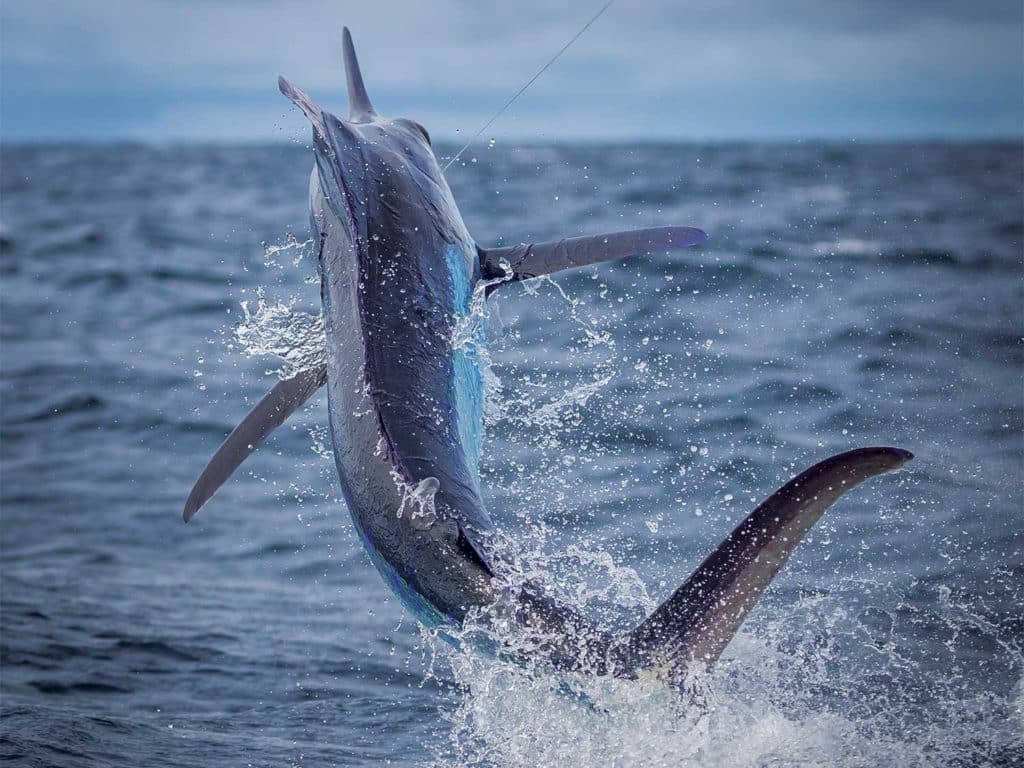
The IGFA currently holds All-Tackle, Line Class, Tippet Class, Junior and Smallfry world records for all of the major billfish species. While the All-Tackle record is the most often referenced, most of the organization’s record participation comes in the form of line-class world records for myriad gamefish species. If you’ve been interested in the prospect of chasing after a record fish—on light line, fly or heavy tackle—there’s no need to look further than the United States coastline.
For example, with swordfish stocks in good shape and new fisheries becoming established, the chance of landing a record sword increases every year. Seasoned captains who have been able to base successful operations in places such as the Florida Keys, Southern California and the Gulf of Mexico means that anglers can target a big one closer to home. But the opportunities aren’t limited to swordfish.
The fame that can come from a record catch is very much warranted, but few are aware of the amount of work and preparation that goes into chasing after such an incredible accomplishment. Countless days of preparation, trial and error, and heartbreak go into landing an IGFA world-record billfish, but sometimes the stars align, and the angler finds himself at the right place at the right time.
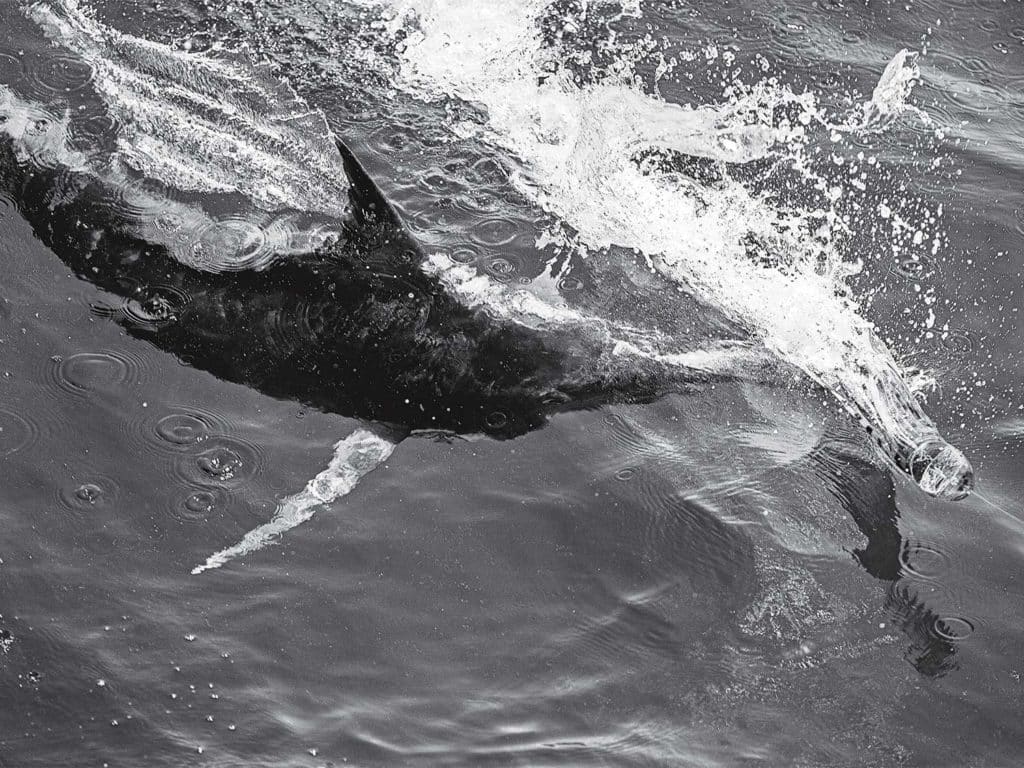
When chasing a record fish, there are many factors that come into play and can stand in the way of an angler’s goal. Finding a captain who is well-versed in light-tackle tactics and techniques is key. This individual must be willing to deal with several lost fish and understand that the angler, captain, and crew must work as a team, and the entire team must have a complete understanding of the IGFA’s International Angling Rules and World Record Requirements, including equipment regulations (which include standards of line and backing, double line, leader, rod and reel, hooks with bait, hooks with lures, and other equipment that includes, but is not limited to, fighting chairs, gimbals, gaffs, and safety lines), angling regulations, and the parameters of acts and situations that will disqualify a catch.
All of this mental tension is then exacerbated to the nth degree when a world record shows up in the spread, because any careless move, mismeasured leader or accidental misstep can cause the entire process to melt down. It takes a cool head and steady hand to make these records come to fruition, and I have nothing but respect for those who can pull it off. Some of the following records date back to the 1950s, which really brings to light the awesome fisheries that have endured in this great nation. So leave your passport at home, and let’s explore some of these world records and the stories behind these awe-inspiring American accomplishments.
Kailua-Kona, Hawaii: Men’s 30-Pound Line-Class World Record
Kelley K. Everette, Pacific Blue Marlin: 1,103 pounds, 8 ounces
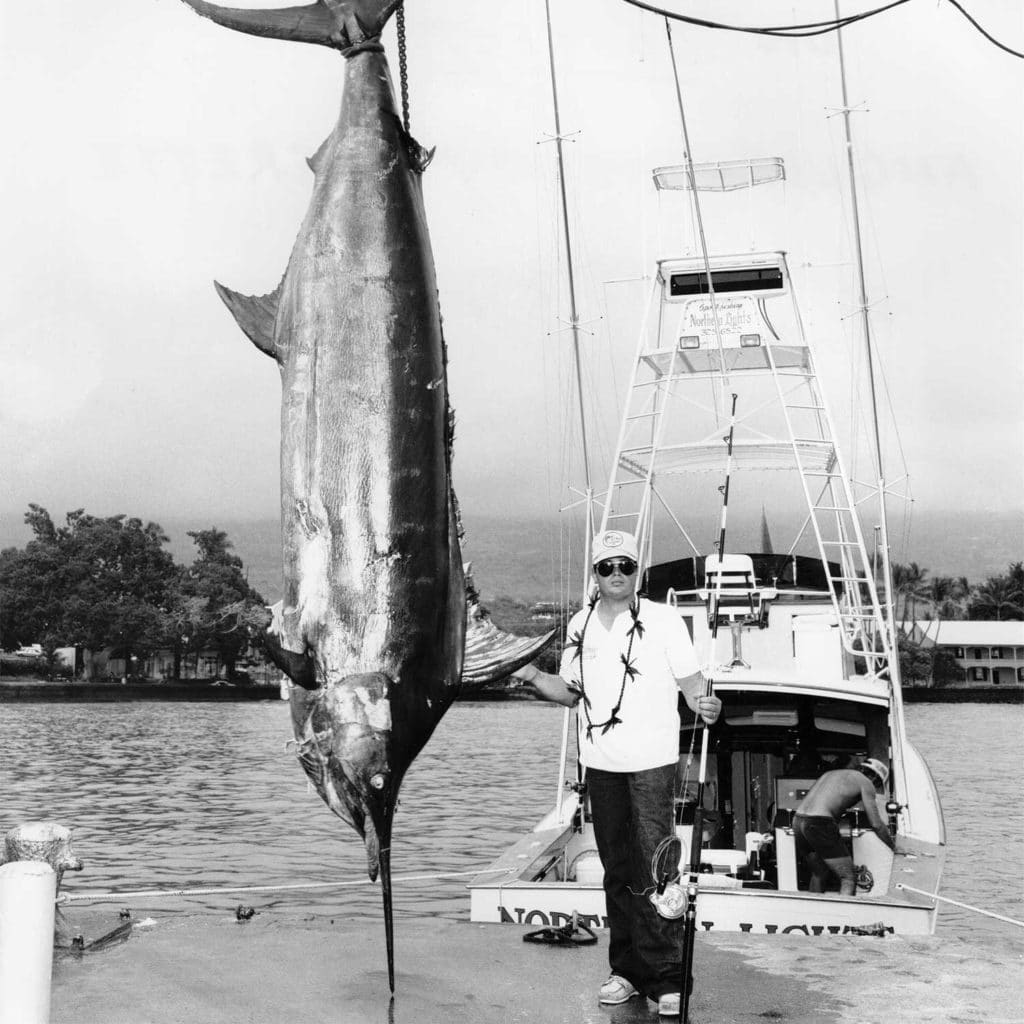
On June 25, 1987, Kelley Everette was fishing on Northern Lights with Capt. Carl Schloderer when he landed this grander Pacific blue marlin. The team left the dock late in the morning, and around 11:15, Everette landed a small skipjack tuna in around 500 fathoms. The crew quickly deployed the small tuna and began to slow-troll the live bait around the VV Buoy, located 3 miles offshore of Kona. After a short time in the water, the skipjack started to behave nervously—and then they got their first look at this massive blue. The marlin inhaled the skipjack and began to peel drag from the Penn International 50 as it made its initial run. Everette settled into the chair and began what would end up being an hour-and-50-minute fight with this record fish. After the lengthy battle, the crew still needed four gaffs to secure the fish next to the boat and then wrestle the large marlin through the door of Northern Lights. Back at the dock, the massive blue weighed in at just over 1,103 pounds, earning Everette the IGFA Men’s 30-pound line-class world record, a mark that has stood for nearly 35 years.
Nantucket, Massachusetts: Women’s 16-Pound Line-Class World Record
Biddy Pauley, White Marlin: 114 pounds
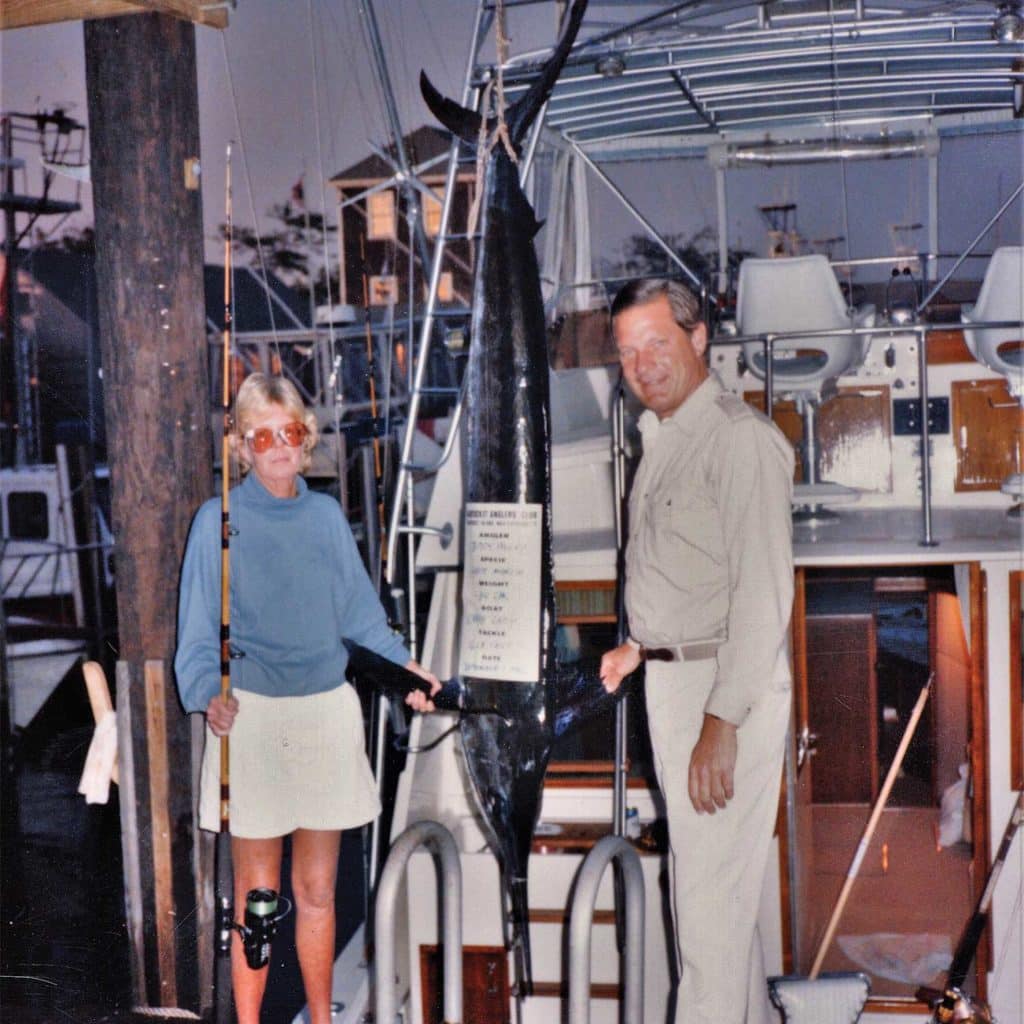
Just 24 hours prior to Howler angler Susan Goodwin landing her 4-pound line-class world-record 97-pound, 4-ounce white marlin, Biddy Pauley showed up to the scales at the Nantucket Anglers Club on September 3, 1986, with this large white. Pauley had been fishing with Capt. Larry Nickel aboard his 42-foot Hatteras, Crazy Lady, when this 114-pound white struck the live scup (also known as a porgy) she had cast. Both of the ladies’ world-record-getting vessels—Crazy Lady and Howler—were fishing an area just south of Nantucket Shoals. A large biomass of white marlin had found a pocket of bait and provided some of the best fishing many anglers had seen in recent years. Pauley’s impressive white marlin took 45 minutes to land and marked a decidedly unique time in angling history because it is so incredibly rare for two impressive records to come from two separate anglers fishing the exact same area on consecutive days.
Martha’s Vineyard, Massachusetts: Men’s Junior World Record
Matthew A. Sheehan, White Marlin: 102 pounds
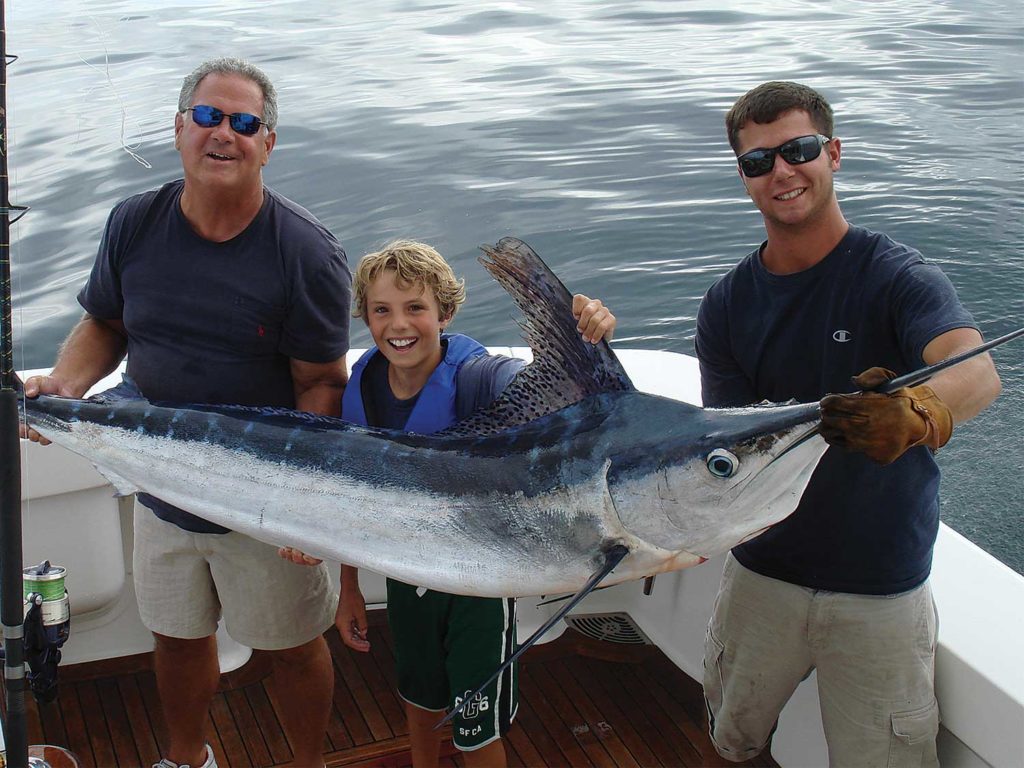
On August 5, 2011, 11-year-old Matthew Sheehan landed this 102-pound white marlin to set the IGFA men’s junior world record for the species. Matthew was fishing alongside his father, Kevin Sheehan, with Capt. Ron Crisp on the 68-foot Viking Humdinger. The Humdinger crew set out that early August morning in search of sharks just south of the island of Martha’s Vineyard. After a slow day of shark fishing, they turned their efforts toward white marlin, and they began to search the shoals south of the island for fish cutting on the surface. Crisp spotted a group of fish, and Matthew made a perfect cast, placing his live scup directly in the strike zone. This large white took the bait, and the fight was on. The junior Sheehan settled into a grueling battle that lasted 90 minutes, covered almost 4 miles, and topped the previous junior record by nearly 44 pounds.
Key West, Florida: Men’s 8-Pound Line-Class World Record
Christian Martin, Atlantic Sailfish: 105 pounds, 4 ounces
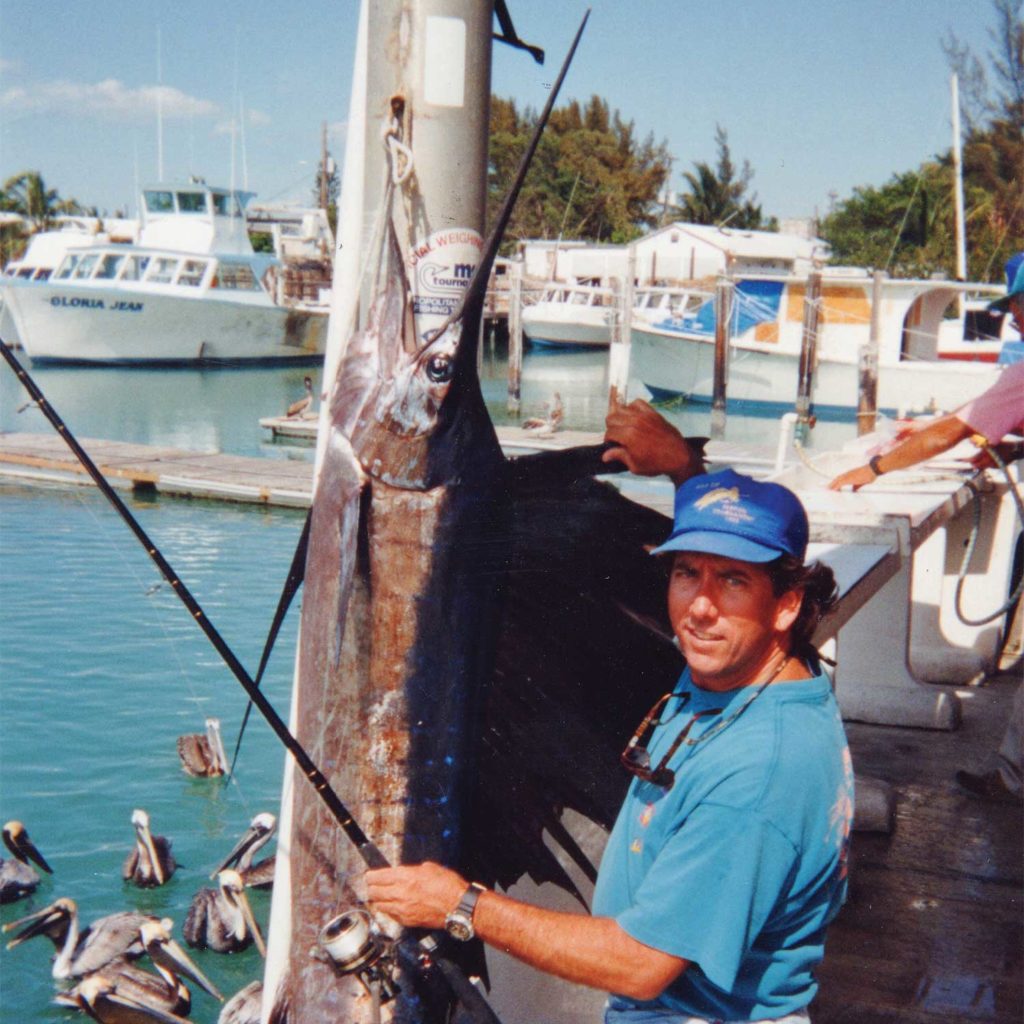
Christian Martin was fishing with legendary Florida Keys captain and guide Ralph Delph aboard the 25-foot SeaVee Vitamin Sea on April 20, 1993. The pair were drifting along a color change in 200 feet of water off Key West, Florida, when this massive Atlantic sailfish struck a threadfin herring on the flat line. In the early stages of the fight, the sail put on an incredible air show. Delph, an experienced sailfish captain, was able to determine that this fish could possibly be a world record. After a 40-minute fight, the duo landed the sail and returned to Key West to weigh it on a certified scale. Martin’s fish weighed in at a mind-boggling 105 pounds, 4 ounces, earning him the IGFA men’s 8-pound line-class world record for the species. Martin’s sail is currently the only world record for the species from the United States, and only one of seven fish coming from the western Atlantic.
Kailua-Kona, Hawaii: Men’s 6-Pound Line-Class World Record
Gary Carter, Shortbill Spearfish: 62 pounds
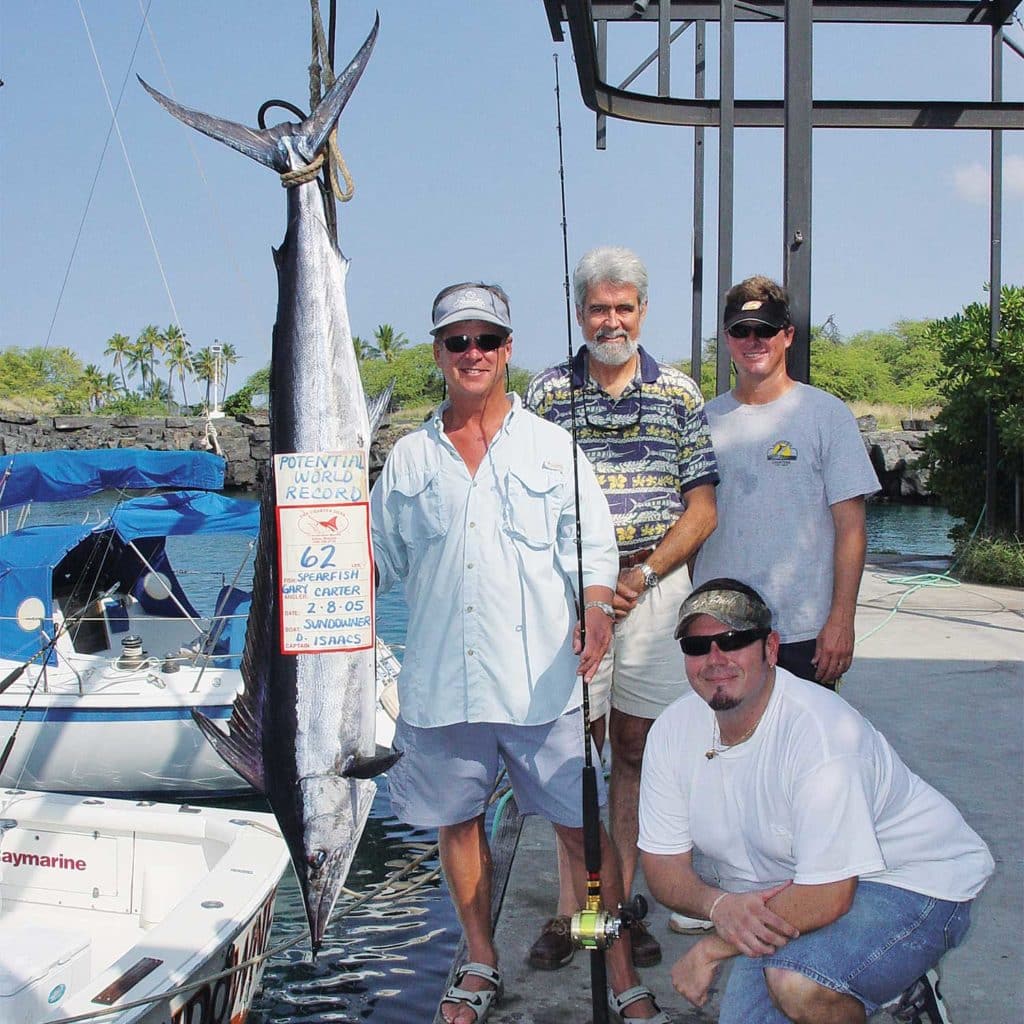
Ten years prior to Gary Carter landing his current 2-pound-test line-class world-record shortbill spearfish, he was in Kona chasing a different line-class record. On February 8, 2005, Carter was fishing with Capt. Darrin Isaacs aboard the 35-foot Bertram Sundowner in search of the men’s 6-pound line-class record spearfish. He was able to accomplish his goal with this 62-pounder after switching the spearfish off a teaser with a rigged ballyhoo. Carter fought the fish for 25 minutes before crewman Jason “Tiny” Walcott was able to gaff the chucker for the world record. The Sundowner crew returned to the Honokohau Harbor fuel dock in Kona for an official weight on a certified scale, where it was confirmed that Carter had indeed caught a new IGFA 6-pound line-class world record. Carter currently holds four light-tackle line-class records for shortbill spearfish. Carter is a legendary world-record holder on both light and heavy tackle, and the majority of his 20 IGFA records were set on 8-pound-test line or lighter. Carter is also an IGFA trustee.
Kailua-Kona, Hawaii: Men’s 12-Pound Tippet-Class World Record
Thomas Irizarry, M.D., Shortbill Spearfish: 37 pounds, 8 ounces
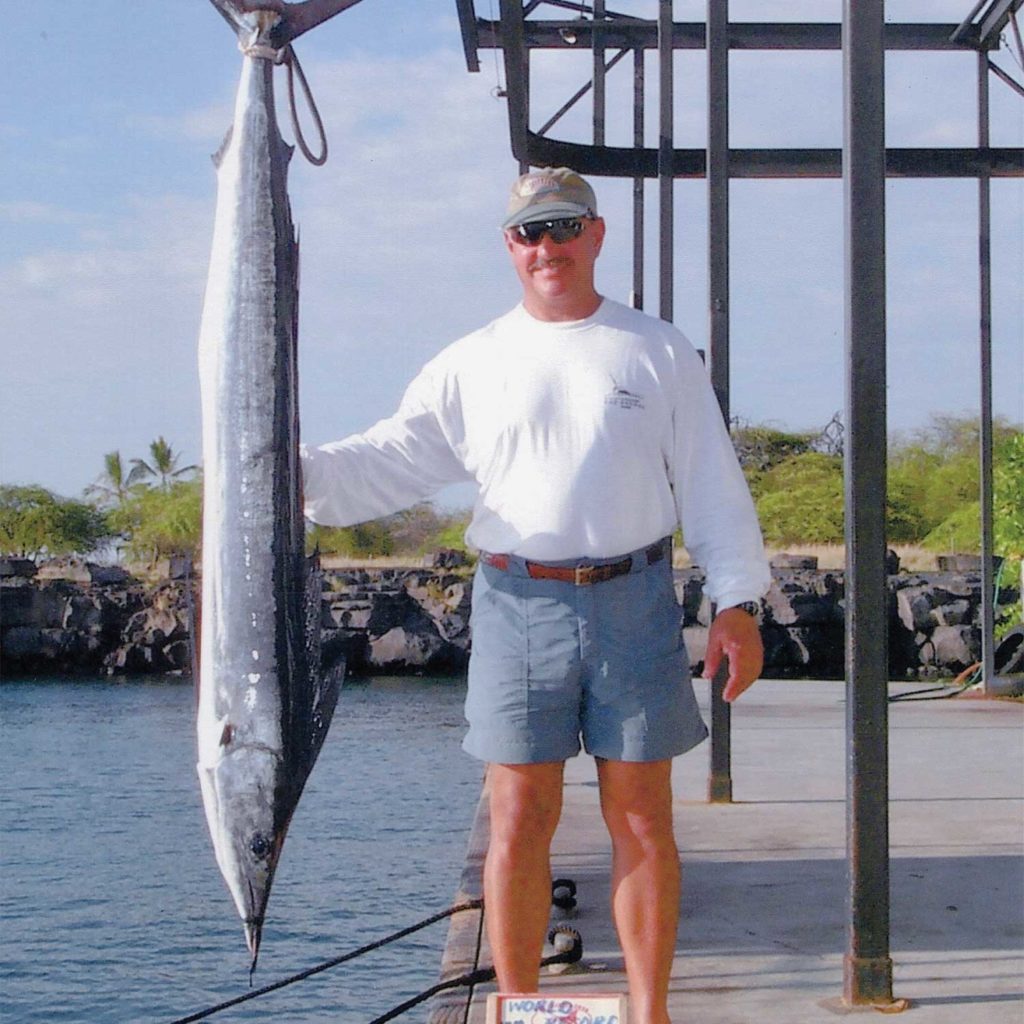
Hooking, much less landing, a billfish on fly is an incredible accomplishment in and of itself, but landing an IGFA world-record billfish on fly is one of the most difficult challenges in the world of big-game fishing. Dr. Thomas Irizarry was able to accomplish just that on February 23, 2003, when he landed this 37-pound, 8-ounce shortbill spearfish, setting the IGFA men’s 12-pound tippet-class world record for the species. Irizarry was fishing out of Kona aboard the 37-foot Merritt Northern Lights, captained by Kevin Nakamaru, when this spearfish took his fly. After a 17-minute fight using a Billy Pate reel and a Cape Fear fly-rod combo, Irizarry was able to bring this specimen to the boat. The crew then returned to Kona’s Honokohau Harbor fuel dock for an official weight on the certified scale. Of the six tippet records the IGFA currently holds for spearfish, four of them have come from the waters off Kona, and eight are currently vacant and up for the taking.
Read Next: Get to know some of the photographers who have contributed to the unique look of Marlin over the years.
Montauk, New York: Women’s 50-Pound Line-Class World Record
Dorothea Cassullo, Broadbill Swordfish: 492 pounds, 4 ounces
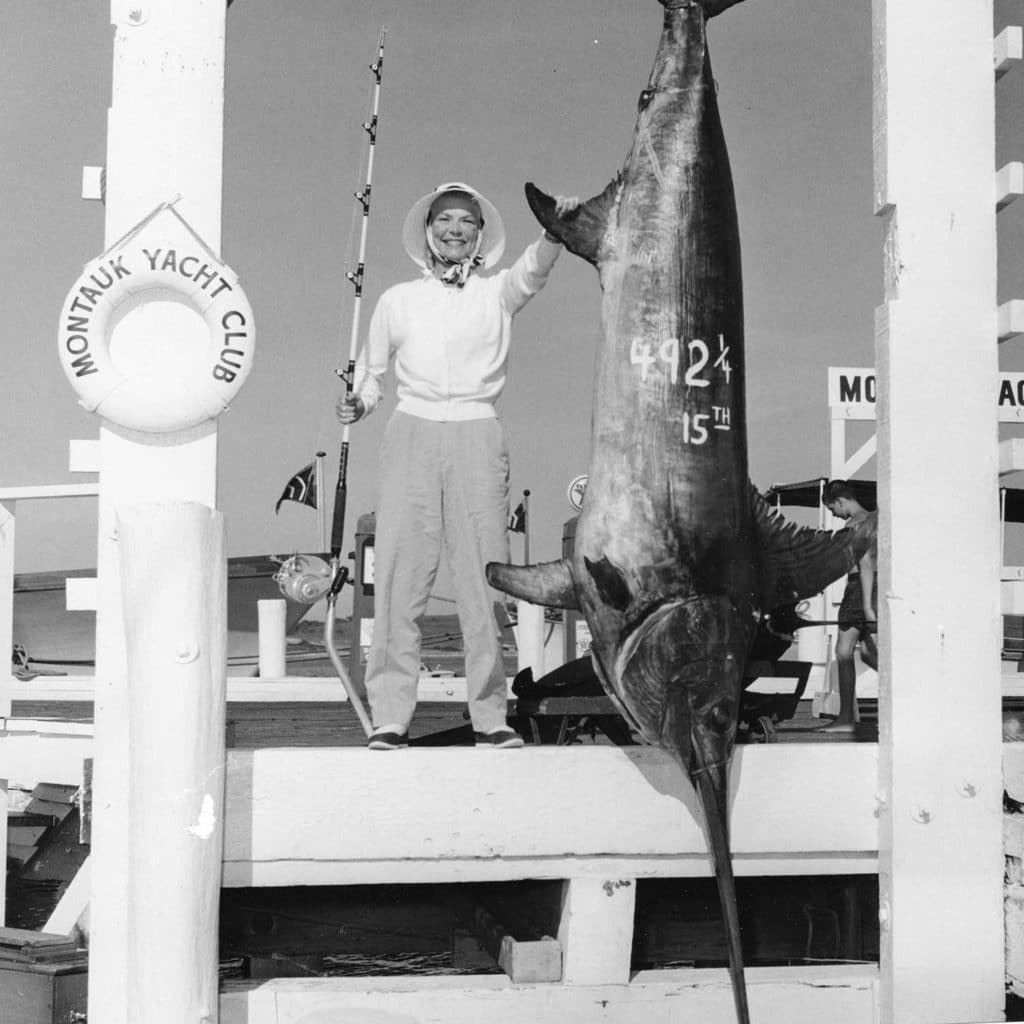
On July 4, 1959, Dorothea Cassullo landed one of the most impressive IGFA swordfish records to date. While trolling a squid roughly 12 miles southeast of Montauk Point off Long Island, Cassullo hooked this massive 492-pound, 4-ounce broadbill. She fought the sword for two hours before the crew of Dorado, captained by Clarence Fine, was able to bring the fish on board. The official weight was certified at Montauk Yacht Club, and Cassullo set the IGFA women’s 50-pound world record for the species. This influential record has maintained its position in IGFA history for more than 60 years.







